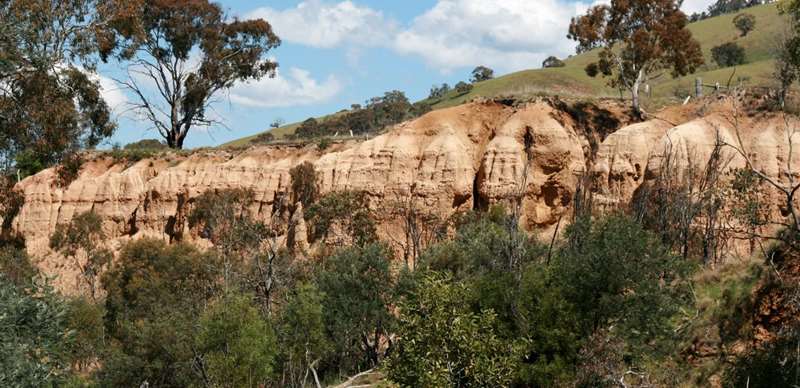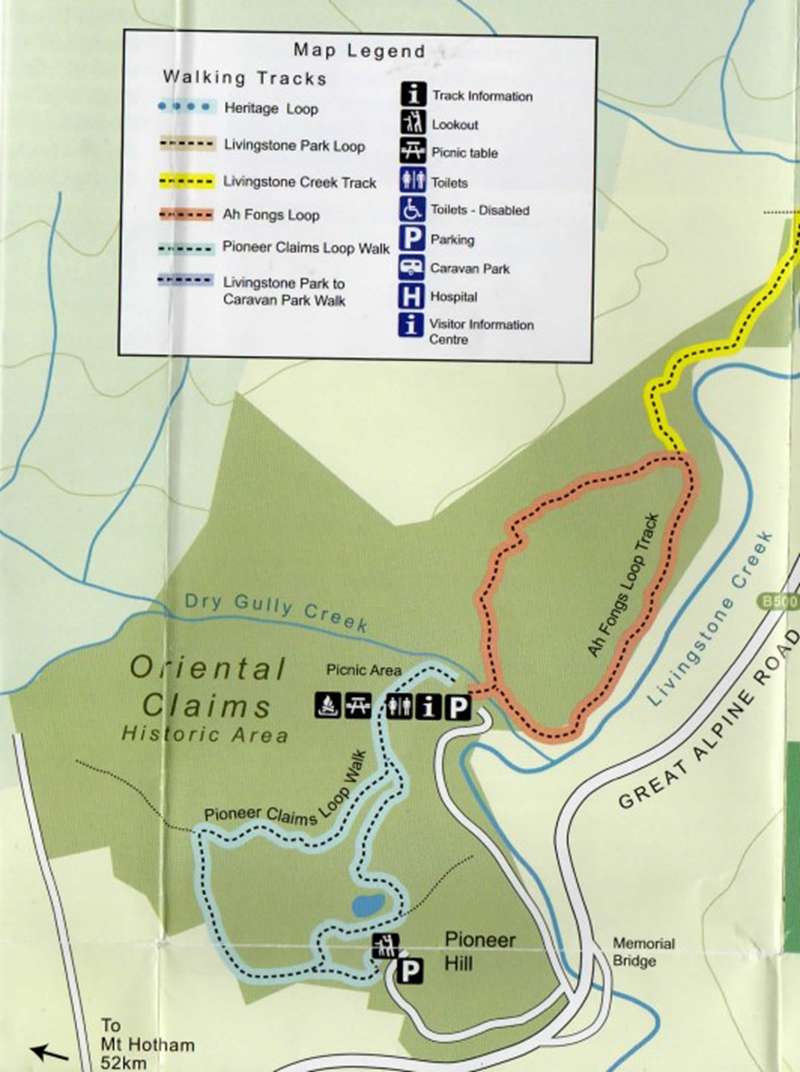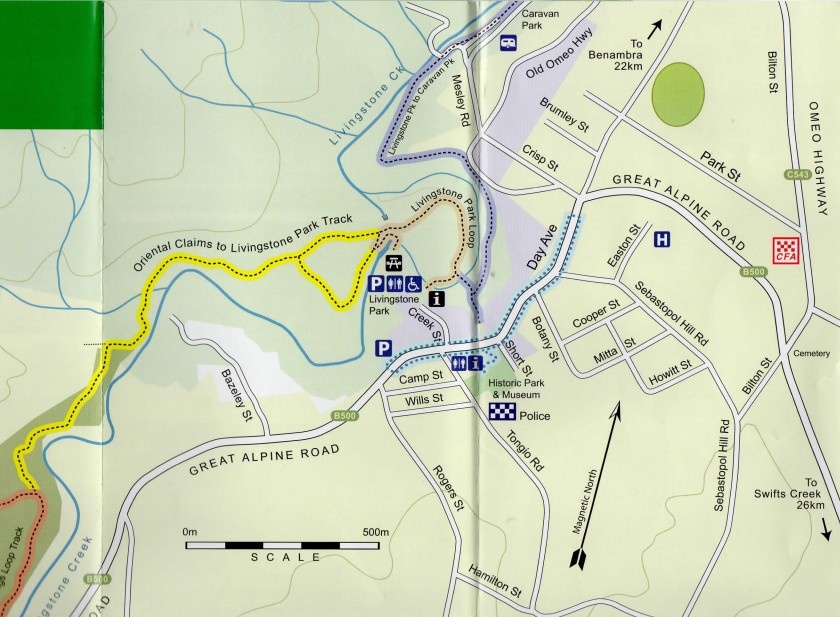Omeo - Oriental Claims Historic Area


The Oriental Claims Historic Area reminds us of a time when this gold rich part of the high country showed sufficient promise to encourage pioneers to forge out an existence in remote mountainous areas. At its peak, the Oriental Claims was one of the largest gold sluicing operations in the world. For more than 50 years prospectors worked the Livingstone Creek area in search of gold. Using a system of water races and high pressure hoses, the mineral bearing soil was extracted from the looming surrounding cliffs.
Walking tracks and interpretive signage guide you through the history of the area and the stories of the Chinese and European miners and their families.
Things To See and Do
Oriental Claims Picnic Area
Toilet, tables, BBQs and fireplaces are provided at the picnic area beside Dry Gully Creek. A display board details stories of the Claims and further information on the surrounding area.
Oriental Claims Historic Area Walks Map

Walks around the Oriental Claims
Ah Fongs Loop - 45 minutes return
Crossing the Dry Gully Bridge, this leisurely walk takes you to the site originally worked by Ah Fong in 1875. It was one of the most extensive and richest sites within the Oriental Claims.
Pioneer Claim Loop - 45 minutes return
The dominant feature of this walk is the rugged cliff faces, up to 30 metres in height, formed by hydraulic sluicing. Also along this walk you may see a variety of orchids (Pink Fingers and Wax Lip and the more common colonies of Spider, Sun and Donkey orchids) from late winter to early summer.
Oriental Claims to Omeo (or vice versa) - 2 hours return
This pleasant walk follows the Livingston Creek to Omeo/ Oriental Claims. Watch out for Swamp Wallabies and the colourful range of native birds (Crimson Rosellas, White-eared Honeyeaters, Eastern Yellow Robins, Superb Fairy-wrens and White-browed Scrubwrens) that can be seen in this area.
Oriental Claims Historic Area Secondary Walks Map

Access for Dogs:
Please keep your dog on a leash at all times.
History
The name of Oriental Claims may conjure up visions of hundreds of Chinese miners working with shovels and wicker baskets filled with dirt. In reality, it refers to a 19th century European mining company 'The Oriental Company', which worked this particular piece of the ground from 1876 until 1904. The term also acknowledges the significant contribution of Chinese miners to the area's history.
Gold was first discovered in the Omeo district in 1851. As it was publicised in the Sydney and Melbourne newspapers, miners were soon heading to the area to stake a claim. In the fifty years that the Claims were consistently worked, its estimated total gold production was 58,000 ounces. At today's prices this would equal around $34million.
The Wardens report of 1854 stated that there were fifty men working around the area and receiving half an ounce a day for their efforts. This worked out at 25-35 shillings per day or approximately 7 pounds per week. By 1856 gold fever had struck the area with a vengeance. A town, soon to be known as Omeo, was emerging with two stores and a hotel.
Alluvial gold, as distinct from reef gold, is concentrated above the bedrock or clay. In most Victorian goldfields the alluviums were worked first, before operations switched to hard rock mining. Often the miners moved to new fields as the alluvial gold dwindled. The Oriental Claims were unique for their alluvial workings - achieving consistent gold production throughout its working history.
The following techniques for gold extraction were used at the Oriental Claims:
Cradle/box sluicing - A box like device is used for separating the gold from wash dirt. Fed in from the top, the wash dirt together with water passes through a screen and then over riffles or bagging where the gold is collected. The combination of box and hydraulic sluicing led to the construction of caves in clay soils around the Claims.
Hydraulic sluicing - This form of mining, referred to as hydraulicking, formed the impressive cliff faces which are still evident in the Claims today. Material was washed down into sluicing boxes by means of high pressure hoses.
The new hydraulicking technique created significant problems with the discharge of mud into Livingston Creek. As a result the 'Sludge Abatement Board' was formed, imposing restrictions and eventually leading to the discontinuation of hydraulic sluicing in 1904.
Standing on top of the cliffs at the Claims it is possible to see how the hardworking miners cut away an entire hill, changing the shape of the landscape forever.
Location and Access
The Oriental Claims Historic Area (approximately 40ha) is 2km south of Omeo or approximately 400km north east of Melbourne and can be reached along the Great Alpine Road from either Wangaratta (via Hume Hwy) or Bairnsdale (Princes Hwy).
If staying in Omeo it is possible to walk to the Claims along the scenic Livingston Creek Walking Track.
Omeo Region Visitor Information Centre has information on walking
tracks, historic images and maps of this fascinating area.
Location
308 Great Alpine Road, Omeo 3898 View Map
Web Links
→ Oriental Claims Historic Area (Parks Victoria)
→ Oriental Claims Historic Area - Park Note (PDF)
→ Omeo Oriental Gold Claims Ah Fong Loop Track (Walking Maps)








